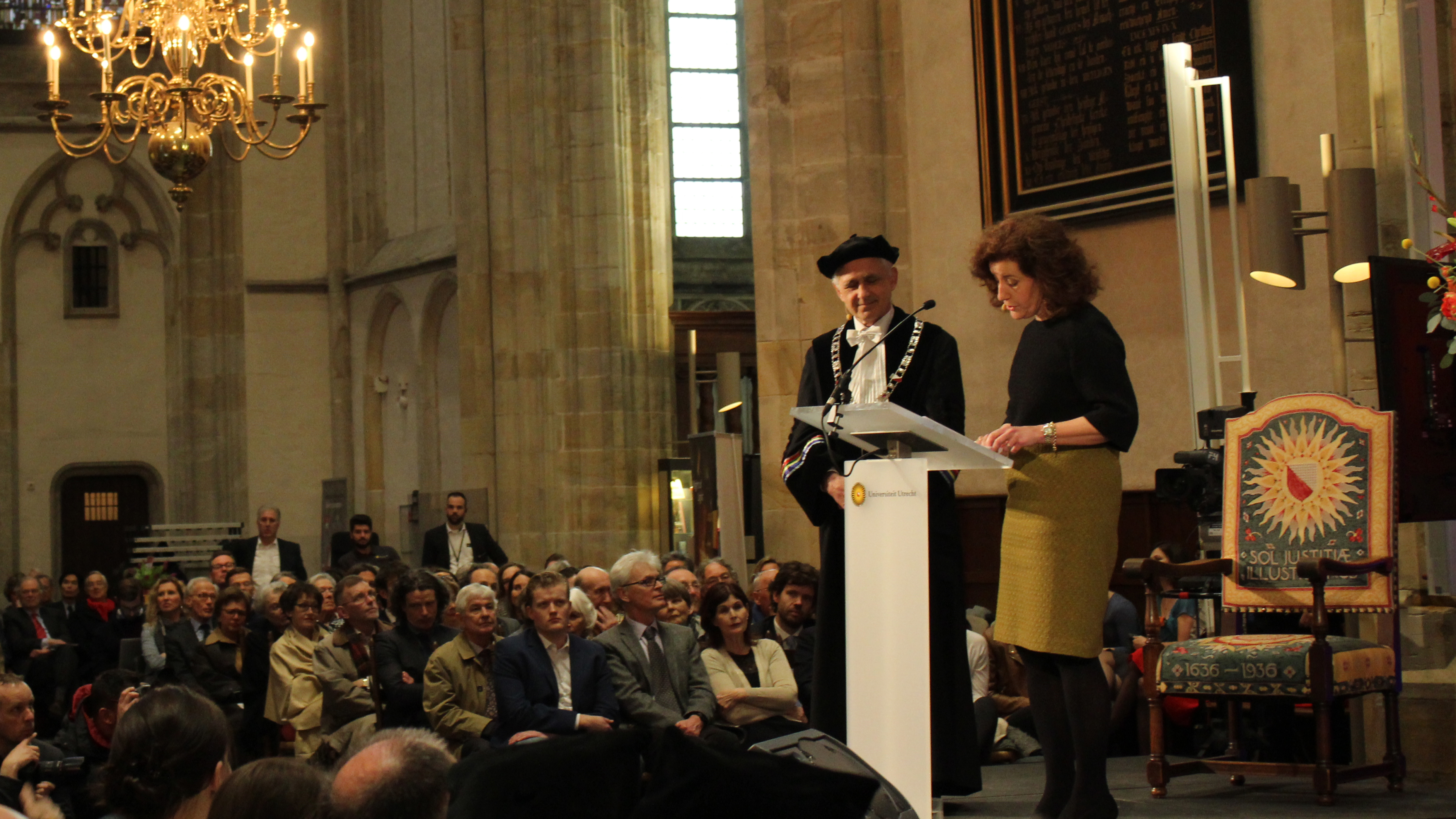Many awards and visions for the future at a packed Anniversary Day
It seems as though the program of the university’s Dies is becoming more and more full each year. Aside from naming the Teacher of the Year and handing out honorary doctorates, there was room in the program for naming the alumnus of the year, two keynote addresses, and amusical intermezzo by Utrecht’s DeKoor and King Rosewood. Still, the ‘service’, as a student called the 382nd anniversary afterwards, was a pleasant gathering. The ceremony didn’t lag, and switching to the next order of business without a presenter went smoothly.
Digitalization of education
Notable was the first speaker of the day, Ingrid van Engelshoven, who’s only been minister of education for barely five months. She began her story by talking about the e-reader, saying everyone expected the digital book to definitively beat the paper version out of existence. But no, the e-reader isn’t that much of a success. She then applied the example to higher education. Education will become more digital. An online class by ethics professor Michael Sandel is more interesting than most of the classes a freshman student has to attend, but at the same time, Van Engelshoven doesn’t think a teacher can be replaced by a digital version, because a teacher inspires, is creative, and can teach public values.
The story flowed seamlessly over to Bert van der Zwaan’s speech. The rector talked about the rise of the robot. Nowadays, robots can perform medical tasks, win games, write novels, and compose music. Applying this idea to higher education, Van der Zwaan warned that the university is falling behind in terms of investing in digitalization. We’re slacking in this, he says. Maybe the future teacher of the year will be a robot.
He drew a parallel to Darwin. If you don’t adapt to your environment, you won’t survive. Still, like Van Engelshoven, he didn’t envision a future in which the university is surrendered entirely to digital devices. You need teachers and researchers to ask questions, to showcase creativity. Variation and differentiation, he says, are the keywords, and he calls for universities to look for the differences. Van der Zwaan says each university should look at which things they want to change, and which they things want to stay the same.
Two honorary doctorates
“I went to the hotel and I asked whether professor Williams had arrived yet. No, the receptionist said, I haven’t seen that man. Of course she hadn’t, because this professor is a woman.” With this classic anecdote, honorary promotor Naomi Ellemers introduced honorary doctor Joan Williams, professor of Law at the university in San Francisco. Fitting, too, because Williams focuses on equality between the sexes and discrimination at the workplace.
The other honorary doctorate was awarded to Albert-László Barabási, physicist and director of Northeastern University for Complex Network Research (CCRN). Honorary promotor Henk Dijkstra praised the honorary doctor for the way he studies complex systems. Dijkstra: “It’s rare to see so many qualities united in one person.” Barabási’s discipline is specialized in ‘Network Science’. He looks at how a network starts, manifests itself, and spreads. This can be a physics-related network of connections, but it can also be about, for example, social media. He researches relations in all networks.
Alumnus of the year
For the third time, the UU presented an alumnus of the year. Suddenly, during the ceremony, a video started to announce the winner: Cathelijne Broers, director of De Nieuwe Kerk and museum De Hermitage in Amsterdam. In the past year, she became very well-known after successfully organizing the exposition Dutch Masters, for which art pieces were brought to Amsterdam from Saint Petersburg.
She studied Art History in Utrecht, and according to her resume, combined it with Business Studies. “Our country of knowledge sorely needs the open mind of art,” she said when awarded the prize, a painting by Nissim Men with cityscapes of places where she has lived, worked and studied.
Teachers of the Year
The Teacher of the Year and the Teaching Talent of the Year were also awarded their prizes. The winners were already announced during the Education Parade, but Teacher of the Year Margot Koster, biology teacher, and Sophie Reinders, teacher of Dutch, now received their awards from study associations Utrecht Biologists Association and Awater.
The wave to say goodbye to the rector
Throughout the entire program, the Bert van der Zwaan’s departure as the university’s 333rd dean was noted. The minister ended her speech by awarding him a commendation as Officer in the Order of Orange Nassau.
Chairman of the Board Anton Pijpers presented him with a portrait of renowned artist Ans Markus, which will be put up on the walls of the Senate room of he University Hall.
He received the university badge with the inscription ‘visionary leader’ from Emmo Meijer, chairman of the Supervisory Board. Meijer compared Van der Zwaan to the painting Victory Boogie Woogie by Piet Mondrian: bright passion, bright colors, boxes of all sizes, and still unfinished in its ultimate form. He christened him Boogiewoogie Bert.
After the official transmission of the rector’s chain to the new rector Henk Kummeling, the celebration was closed with a symbolic farewell. Everyone received gigantic handkerchiefs with an image drawn by DUB cartoonist Niels Bongers. Those present waved goodbye to the rector with a wave from the front to the back of the church.